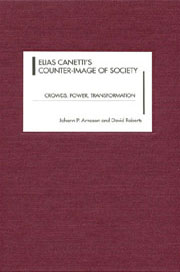1 - The Auto-da-Fé of Civilization
Published online by Cambridge University Press: 05 February 2013
Summary
In the second volume of his autobiography Canetti recalls the burning of the Palace of Justice in Vienna in 1927. The events of that day of riots and violence were to be seminal: from the experience of the mysterious and contagious power of the crowd came the central theme of his life's work, and an image — an official of the Ministry of Justice surrounded by burning files — which was to act as a catalyst for Auto da Fé, written three years later. The novel unfolds an apocalyptic vision of European society on the edge of the volcano, blind to its destructive other, the eruptive force of the crowd. What Canetti understands by the crowd is the focus of the present chapter, since it forms the imaginative background to his subsequent writings without ever appearing again in such a comprehensive, mythical fashion. I say “mythical” in order to characterize Canetti's antithetical stance towards the scientific appropriation of the world, which must be seen in the context of the cultural criticism of the time (Cultural Crisis). To the onto-logic of the “head” the novel opposes a mytho-logic of the “world,” which is explored in relation to the blindness of philosophy to the Heraclitean flux of being, the “magma” underlying the western tradition of ontology (The World as Magma and Monad), in relation to the blindness of sociology to the other of the “society of individuals” and its negative anthropology (The Society of Individuals), and in relation to the blindness of psychology to the “mass-soul” beneath our supposed individuality (The Mass-Soul).
- Type
- Chapter
- Information
- Elias Canetti's Counter-Image of SocietyCrowds, Power, Transformation, pp. 5 - 26Publisher: Boydell & BrewerPrint publication year: 2004



